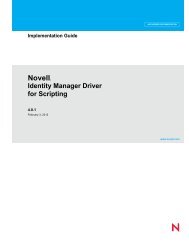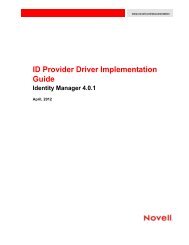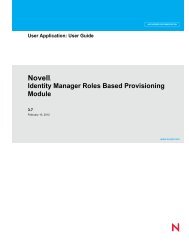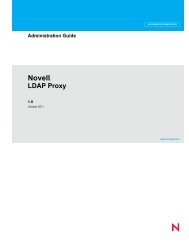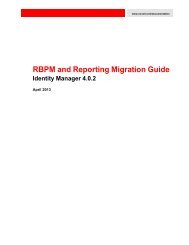Novell eDirectory 8.8 Installation Guide - NetIQ
Novell eDirectory 8.8 Installation Guide - NetIQ
Novell eDirectory 8.8 Installation Guide - NetIQ
Create successful ePaper yourself
Turn your PDF publications into a flip-book with our unique Google optimized e-Paper software.
Configuring Static IP Address<br />
Refer to “Configuring Static IP Address” on page 12 for more information on configuring static IP<br />
addresses.<br />
3.3 Hardware Requirements<br />
Hardware requirements depend on the specific implementation of <strong>eDirectory</strong>. Two factors increase<br />
performance: more cache memory and faster processors. For best results, cache as much of the DIB<br />
Set as the hardware allows.<br />
novdocx (en) 11 July 2008<br />
<strong>eDirectory</strong> scales well on a single processor. However, <strong>Novell</strong> <strong>eDirectory</strong> <strong>8.8</strong> takes advantage of<br />
multiple processors. Adding processors improves performance in some areas — for example, logins<br />
— and having multiple threads active on multiple processors also improves performance. <strong>eDirectory</strong><br />
itself is not processor intensive, but it is I/O intensive.<br />
The following table illustrates typical system requirements for <strong>eDirectory</strong> for Linux:<br />
Objects Processor Memory Hard Disk<br />
100,000 Pentium III 450-700 MHz (single) 384 MB 144 MB<br />
1 million Pentium III 450-700 MHz (dual) 2 GB 1.5 GB<br />
10 million Pentium III 450-700 MHz (2 to 4) 2+ GB 15 GB<br />
Requirements for processors might be greater than the table indicates, depending upon additional<br />
services available on the computer as well as the number of authentications, reads, and writes that<br />
the computer is handling. Processes such as encryption and indexing can be processor intensive.<br />
3.4 Forcing the Backlink Process to Run<br />
Because the internal <strong>eDirectory</strong> identifiers change when upgrading to <strong>Novell</strong> <strong>eDirectory</strong>, the<br />
backlink process must update backlinked objects for them to be consistent.<br />
Backlinks keep track of external references to objects on other servers. For each external reference<br />
on a server, the backlink process ensures that the real object exists in the correct location and verifies<br />
all backlink attributes on the master of the replica. The backlink process occurs two hours after the<br />
database is open, and then every 780 minutes (13 hours). The interval is configurable from 2<br />
minutes to 10,080 minutes (7 days).<br />
After migrating to <strong>eDirectory</strong>, start the ndstrace process by issuing the ndstrace -l>log&<br />
command, which runs the process at the background. You can force the backlink to run by issuing<br />
the ndstrace -c set ndstrace=*B command from the ndstrace command prompt. Then<br />
you can unload the ndstrace process by issuing the ndstrace -u command. Running the backlink<br />
process is especially important on servers that do not contain a replica.<br />
3.5 Upgrading <strong>eDirectory</strong><br />
• Section 3.5.1, “Server Health Checks,” on page 49<br />
• Section 3.5.2, “Upgrading on Linux Servers Other Than OES,” on page 49<br />
48 <strong>Novell</strong> <strong>eDirectory</strong> <strong>8.8</strong> <strong>Installation</strong> <strong>Guide</strong>




